Contribution[Part 3] Toward a Future of Human Security and Well-being (2 of 3)Monozukuri a Specialty of Japan
Evolution of Ability to Make Things, Unique to Modern Humanity
The Japanese term “monozukuri” has a variety of definitions depending on which dictionary you consult. It likewise has numerous different English translations.
The digital edition of the Daijisen Japanese dictionary defines it as “making things, especially in the sense of experienced craftspeople utilizing their skills to create highly intricate objects.” I expect that people in the science and technology sector would have no problem with this definition.
For myself, however, I believe that the term also has a distinctive and important sense that, as far as I have been able to determine, is not given in any dictionary. This is that, in a physical as well as a functional sense, monozukuri has enabled the evolution of a new type of nervous system specific to modern humans. This is an extension to the nervous system that links the movement and touch of our fingers to our brain, and is something that does not exist in our closest living relative, the chimpanzee. It is also the main reason why modern humans (Homo sapiens sapiens), the only living members of the genus Homo, are capable of playing musical instruments such as the piano or violin with a very high level of proficiency. While I will leave the comparative anatomy to another time, I believe that this has a deep connection with these finger movements and the genius of Albert Einstein (1879-1955). Fingertip movement is tied directly to high-level thinking and creativity*1.
In this article, I intend to go beyond this to look at the nature of monozukuri and how Japan once became a world leader in the building of aircraft, recounting the story now largely forgotten of the part that civil aviation and the Tokyo Imperial University Aeronautical Research Institute played in this, and how this story connects with Namihei Odaira.
- *1
- Hideaki Koizumi, “Einstein Reverse Omega: Evolutionary Pedagogy,” Bungeishunju (2015)
Traditional Monozukuri in Terms of History of Academies
Scientific and engineering academies with long histories are valued highly in most advanced nations where they are seen as complimentary to one another. This is because they strike a balance between fundamental research and applied development, especially when it comes to monozukuri.
The first scientific academies got their start at the dawn of modern science. The oldest is the Vatican’s Pontifical Academy of Sciences that started out as the Accademia Nazionale dei Lincei. Founded in Italy in 1603, it dates back more than 420 years. Galileo Galilei (1564-1642) was an early member. At the 400th anniversary symposium held in 2003, I was invited to give a presentation and I also received a medal*2.
- *2
- My invitation to give a presentation to mark the 400th anniversary of the Pontifical Academy of Sciences at the Memorial Symposium entitled “Mind, Brain, and Education” in November 2003 came about as follows.
- A four-day international conference entitled Brain Science and Education was held in January 2000 to consider the prospects for scientific technology and education in the 21st century. The conference was sponsored by the Science and Technology Agency (STA)/ Japan Science and Technology Corporation, Japan’s current Japan Science and Technology Agency (JST) and I served as chairperson of the organizing committee, including publishing an English-language edition of the proceedings. The idea behind it came from a session entitled “Interaction between Brain and Environment” at a similarly sized international conference on the global environment held in February 1996.
- “Advanced Brain Imaging (Hitachi): Hitachi Advanced Research Lab’s brain science applications program breaks the mold with research to improve education through brain imaging” was selected in the January 2003 edition of MIT Technology Review as one of the world’s four breakthrough technologies of 2002. The other three were quantum computing (Microsoft), electricity producing vehicles (GM), and nano ceramics (GE).
- The technology was covered during a special session on “Brain & Learning: A Revolution in Education for the 21Century” held as part of the OECD Forum 2002 (in May 2002) and featured as an innovative new approach to education in the OECD’s Forum Highlights publication. In 2002, an international joint research program compiled at that time was also published in book form in English, French, and Spanish. The text remains available from the OECD at the following URL.
https://www.oecd.org/en/publications/understanding-the-brain_9789264174986-en.html
Another scientific academy with a long history is Germany’s National Academy of Sciences Leopoldina. The institution began as the Academia Naturae Curiosorum (Academy of the Curious as to Nature) in 1652 and was subsequently designated as an academy by Leopold I (1640-1705) in 1677.
The French Academy of Sciences was founded as a scientific academy in 1666 by Louis XIV (1638-1715) (see Figure 7-1,Figure 7-2 in Article 1 of Part 2).
In the USA, the National Academy of Sciences was founded by Abraham Lincoln (1809-1865) in 1863, not long before his assassination. More recently, the National Academy of Sciences, National Academy of Engineering, and Institute of Medicine were merged in a 2015 reorganization to form the National Academies.
Founded in 1645, the historic Royal Society in the UK was the world’s first non-government academic association, something that marks it out from other national academies. In China, meanwhile, the Chinese Academy of Sciences and Chinese Academy of Engineering both play a leading role in Chinese science and technology. Both institutions also cover medical science, being structured to address the theoretical and applied areas, respectively. Currently, five Japanese researchers are recognized as foreign academicians by the Chinese academies (including the Nobel Prize winners Hiroshi Amano and Satoshi Omura). I myself became one in 2011.
As Japan lacks any history of scientific academies, institutions such as the Japan Academy (part of the Ministry of Education, Culture, Sports, Science and Technology) and the Science Council of Japan (part of the Cabinet Office) differ from overseas scientific academies by being governmental agencies in a model that is unique to Japan. This makes it difficult to establish strong ties with the official academies of other countries.
Meanwhile, the world’s first engineering academy, the Royal Swedish Academy of Engineering Sciences (IVA) was established in 1919. More recently, the International Council of Academies of Engineering and Technological Sciences (CAETS) was established in 1978 and currently recognizes national engineering academies from 33 different countries as satisfying its criteria. The Engineering Academy of Japan (EAJ) currently has about 900 full or affiliate members and was the 10th academy to gain CAETS recognition, doing so in 1990 after passing through a rigorous approvals process. It is heavily involved in international activities in partnership with other nations.
I am currently an EAJ advisor and have previously served as the EAJ executive vice-president and the chair of the EAJ international committee. I also served two terms (2+2 years) as a CAETS director where I focused on collaboration and cooperation activities that are in tune with the academic and cultural practices of countries with different political systems. My involvement included getting a proposal adopted to include engineering ethics among the objectives listed in Article 1 of the CAETS bylaws. I also put a lot of effort into clearly enshrining the principle that academies are neutral organizations and independent of politics.
Given the role currently occupied by the world’s engineering academies, I am conscious that Japan’s strong affinity with monozukuri will remain steadfast in the future. Key insights as to why this is so can be found by looking at primary sources and what is happening on the ground. In Japan, the management of research and development gained importance during its time of rapid economic growth, with specialists in this management tending to be highly influential in corporate management and science and technology policy. Unfortunately, experience of research management does not on its own facilitate an appreciation of what monozukuri really is.
As it happens, the University of Tokyo in its early years got its start as the world’s first engineering education facility. An engineering school based on the college model from the UK was established in the Ministry of Public Works in 1871 (the fourth year of the Meiji Era). Henry Dyer (1848-1918) played a leading role among teaching staff brought in from the UK and the Imperial College of Engineering was formally established in 1877 under his direction. The college subsequently merged with the faculty of crafts at the University of Tokyo in 1886. It also later merged with the engineering faculty of Imperial Universities in 1897 to become the Tokyo Imperial University Faculty of Engineering. The Western world at that time saw engineering and medicine as professions and did not regard them as academic fields. While there were moves underway to establish engineering schools in the UK (especially in Scotland), with Henry Dyer among the leading figures in this movement, his invitation to Japan led to our nation becoming the first to establish such a college. In other words, historically speaking, it is no exaggeration to say that monozukuri is something of a specialty for Japan.
The EAJ was recognized as the official national academy of Japan by CAETS. Having gone through this process, people at EAJ subsequently put a lot of effort into gaining CAETS membership for other Asian countries such as China and South Korea. This has helped to forge a bond of trust between Japan, China, and South Korea and led to the 1998 launch of the East Asia Engineering Academies Round Table Meeting (EA-RTM) in which the three nations play a central role. The three nations have since taken turns to host annual gatherings, with the 2025 EA-RTM being the 27th such meeting. I have been reminded nearly every year since 2010 of the great strides being made by China and South Korea. While this debate between nations that operate under different systems is, strictly speaking, limited to what information has been made public, it still provides ample opportunity for efforts to discuss and realize a better future for humanity.
Most of the nations that belong to CAETS also have their own scientific academy. It is important that engineering academies and scientific academies operate in tandem.
Neutrality and independence from politics are fundamental requirements for an academy. The operation of the EAJ is funded by the fees paid by academy members (fellows and affiliated companies) and by donations from public utility foundations or funds. Public funding from the government is only provided for those activities organized or run by the academy that are authorized by the government.
The same is true of the Pontifical Academy of Sciences, the scientific academy with a longer history than any other. Its neutrality and freedom are guaranteed. This involves: (1) Freedom of religious belief, (2) Independence from politics, (3) No distinction based on gender or race, and (4) Full disclosure of discussions and outcomes.
Figure 1—Commemorative Photograph at 400th Anniversary of the Foundation of the Pontifical Academy of Sciences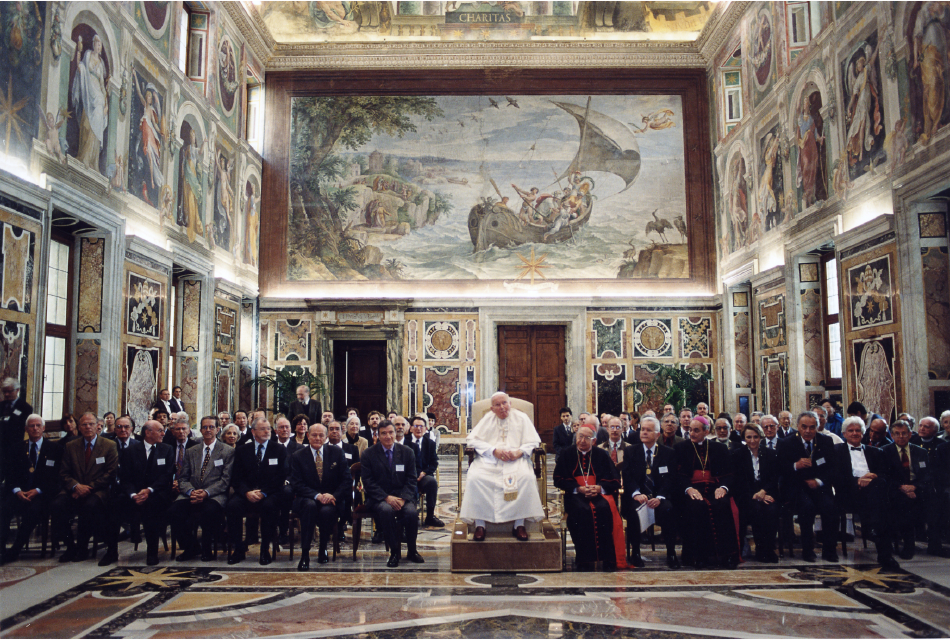 “Mind, Brain, and Education: The Session Commemorating the 400th Anniversary of the Foundation of the Pontifical Academy of Sciences (1603-2003),” a symposium to mark the 400th anniversary of the Pontifical Academy of Sciences, was held in 2003.
“Mind, Brain, and Education: The Session Commemorating the 400th Anniversary of the Foundation of the Pontifical Academy of Sciences (1603-2003),” a symposium to mark the 400th anniversary of the Pontifical Academy of Sciences, was held in 2003.
The 400th anniversary symposium was followed by each of the commemorative lecturers being introduced to Pope John Paul II and having the opportunity to exchange a few words. The event was attended by numerous Nobel laureates. (Photograph courtesy of Roman Curia)
Figure 2—Opening Ceremony for General Assembly of the Members of the Chinese Academy of Sciences and Chinese Academy of Engineering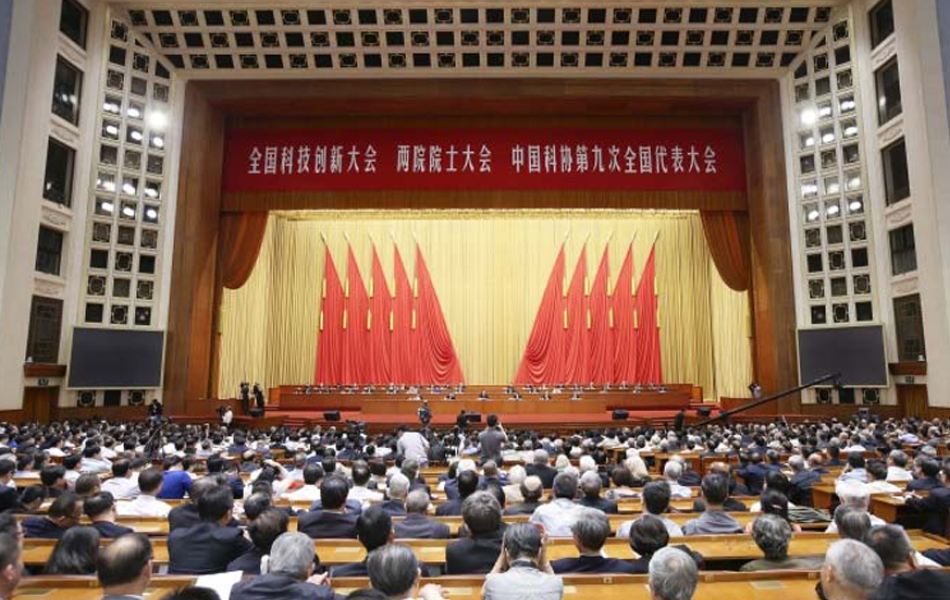 A General Assembly of the Members of the Chinese Academy of Sciences and Chinese Academy of Engineering was held at the Great Hall of the People in Beijing in 2014. The Chinese Academy of Sciences and the Chinese Academy of Engineering are referred to as the “Two Academies,” with both institutions also covering medical science, addressing theoretical and applied areas separately. The combined general assembly of the two academies is held every two years to determine policy directions for Chinese science and technology. (Photograph courtesy of Chinese Academy of Engineering. EAJ NEWS, No. 167, pp. 5-6, 2016.9)
A General Assembly of the Members of the Chinese Academy of Sciences and Chinese Academy of Engineering was held at the Great Hall of the People in Beijing in 2014. The Chinese Academy of Sciences and the Chinese Academy of Engineering are referred to as the “Two Academies,” with both institutions also covering medical science, addressing theoretical and applied areas separately. The combined general assembly of the two academies is held every two years to determine policy directions for Chinese science and technology. (Photograph courtesy of Chinese Academy of Engineering. EAJ NEWS, No. 167, pp. 5-6, 2016.9)
https://www.eaj.or.jp/app-def/S-102/eaj/wp-content/uploads/2017/01/EAJ_NEWS_0167.pdf
Why Monozukuri is so Important: New Motor Nervous System Acquired by Modern Humans
While software predominates at many of today’s largest corporations, that software is underpinned by semiconductors and materials science. The provision of a positioning service, for example, could not be accomplished without monozukuri skills. Rocket science, among other things, is needed to launch the satellites, and hardware is required for the base stations and relays. Similar requirements apply in other areas such as the supply of electricity.
Taking humans as an example, the central nervous system, especially the brain, serves as the hub for software, while hardware in the form of the respiratory, circulatory, digestive, motor, and other systems that run on energy and entropy also play a fundamental role. In other words, modern humans serve as another demonstration of how important the concept of monozukuri is.
Humans construct an internal representation of the world by acquiring information from the environment (external world) by means of the five senses (sight, hearing, touch, taste, and smell) and processing it, primarily in the brain. From this internal world, we then output information or actions by means of our muscles, which by and large are our only output mechanism. Whether it be tapping a key, speaking, or writing, muscle movement is needed for all of our actions. The collective activities of the individuals who make up a society are accomplished on a basis of infrastructure and information. This is where all the world’s urban problems come from.
Figure 3—Relationship between Mind and Matter (including the Body)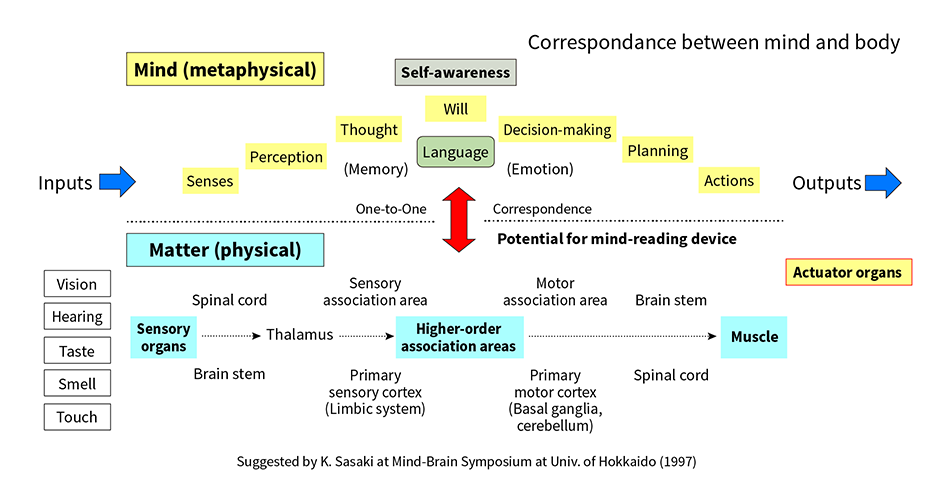 The inputs to the human body are acquired by means of our sensory organs (the five senses of sight, hearing, touch, taste, and smell). Output, on the other hand, is generally accomplished by muscle action. This means that we would be unable to convey any information to the outside world were the nervous system that delivers information to our muscles to fail, leaving us in what is known as a prolonged disorder of consciousness.
The inputs to the human body are acquired by means of our sensory organs (the five senses of sight, hearing, touch, taste, and smell). Output, on the other hand, is generally accomplished by muscle action. This means that we would be unable to convey any information to the outside world were the nervous system that delivers information to our muscles to fail, leaving us in what is known as a prolonged disorder of consciousness.
Being able to securely hold onto branches and support our own weight when moving around in trees is an important ability for primates, humans included. All primates have evolved nervous systems that can get a good grip on a tree branch.
If you get a chimpanzee, our closest relative among other species, to tap a touch panel, it will not touch the screen with the tip of a finger the way we would do it. Instead, the chimpanzee will hold its fingers slightly clenched and touch the input screen using its knuckles.
When it comes to creating more complex stone or earthenware tools, however, being able to clench one’s fingers is not enough and the ability to move fingers independently is also important. When humans achieved upright locomotion it freed up both hands and provided greater opportunities for finger use. That our stone or earthenware tools gradually became more elaborate over a long period of time was because we had evolved the ability to move each of the five fingers on our left and right hands independently. Of particular importance to monozukuri was the gripping action we could perform using our thumbs and opposing fingers. This involved the evolution of a new type of nervous system in which there was an improved link between the muscles of our fingers and the regions of the brain responsible for issuing motor commands. As you could demonstrate for yourself by throwing a ball, you will not throw very accurately or far if you grasp the ball too tightly. The tricky curve balls thrown by baseball pitchers are accomplished through fine control of their five fingers. The same applies when playing the piano or violin.
Figure 4—Difference between Tight and Loose Gripping Actions, and Evolution of New Nervous System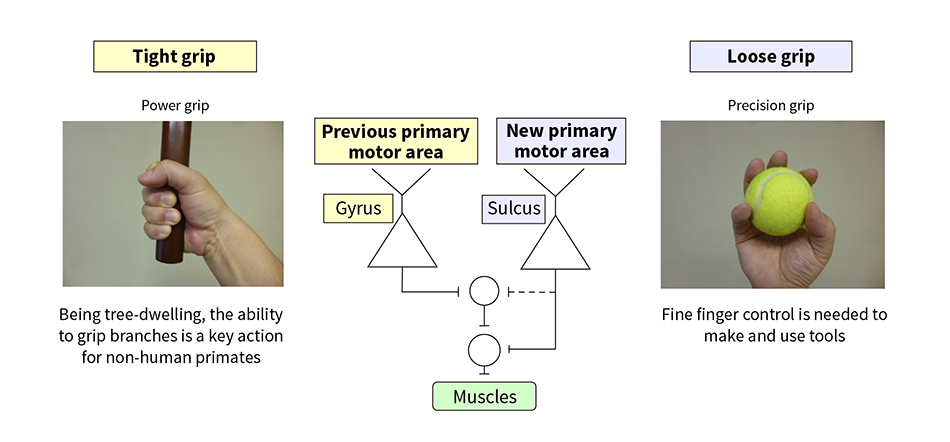 Like other mammals, when humans or other primates move around in forest trees, we transmit motor commands from our cerebral cortex via the spinal cord to our muscles. This ultimately led to modern humans, the achievement of bipedal locomotion that freed up use of our fingers, and the acquisition of the skills to manufacture stone or earthenware tools. We even went on to evolve a new nervous system for the purpose. This took the form of new nerve circuits that link the brain to the individual muscles in our fingers.
Like other mammals, when humans or other primates move around in forest trees, we transmit motor commands from our cerebral cortex via the spinal cord to our muscles. This ultimately led to modern humans, the achievement of bipedal locomotion that freed up use of our fingers, and the acquisition of the skills to manufacture stone or earthenware tools. We even went on to evolve a new nervous system for the purpose. This took the form of new nerve circuits that link the brain to the individual muscles in our fingers.
Development of Measurement Instrument Underpinned by Quantum Physics (Polarized Zeeman Atomic Absorption Spectrophotometer)
I would like to provide a practical example of the importance of primary sources and how things are done in practice, especially monozukuri.
The measurement technique I am about to describe has been utilized in more than 10,000 systems around the world; these systems have been featured in catalogs for nearly half a century. The method is based on a principle that was discovered from monozukuri and, as a consequence, how it works remains for the most part poorly understood in the applications where it is used (including environmental and medical uses). Its principle of operation has been published in various journals in the fields of optics and analytical chemistry, with the 50th anniversary of the initial 1976 paper coming in 2026. In 1977, a year after this initial publication, it was reported as a research news item in the US journal Science.
The principle is as follows. The way photons are currently used in quantum computers involves their having only two states (interpretable as spin states that represent 1 and 0 respectively). In terms of the binary system, which has its origins back with the I Ching, as I wrote in Article 1 of Part 3, this represents a single positive or negative bit. To measure absolute values for a material, a photon beam is passed through it that is tuned to the specific quantum energy potential of its outer-shell orbital electrons, causing resonance at this same energy (wavelength).
When this is done, electrons can be raised to a higher energy level by absorbing the energy of an incoming photon. As this absorption of photons reduces the photon density, it can be used to measure the atomic density of the specimen. An entirely new way of doing this, however, is to utilize two different photon states and only measure the difference between these. As the two states will have the same density, this difference will always be zero. This is because there will always be the same number of photons with each of the two spin states.
If the material being measured is also exposed to a magnetic field, however, the degeneracy of the magnetic quantum number can be determined for the quantum state of the material’s outer-shell orbital electrons. When this is done, the electrons will undergo a very small energy shift that is proportional to the applied magnetic field. This shift is in the order of about 30 GHz (1 cm−1). If photons are used that have a sharp atomic resonance line at around several GHz, those energy-shifted photons that correspond to a 1 will not interact with electrons. Accordingly, the difference between photons in the states that represent 0 and 1 will be large enough to be measured. Even if the sample contains contaminants, the signal will always be zero. That is, a proportional signal will only be obtained if the specific element being measured is present. No matter how much the intensity of the light source with sharp atomic spectral lines fluctuates, this new measurement technique will be entirely immune to this variability because it works by measuring the difference between the two photon states. This enables analyses to be performed with extremely high precision. (This new principle does not use the concept of “entanglement” as applied in quantum computing.)
Everything in the process of verifying this principle involved monozukuri. A requirement for practical application is that measurements not be affected by the contaminants that are invariably present in real samples. This is where the strength of quantum physics shows itself. The method has been able to analyze various samples that were beyond the measurement capabilities of previous methods, even when deployed in the demanding application of environmental assessments for US military bases around the world. There was also a time when the method was used around the clock to uncover the cause of Minamata disease, utilizing its ability to measure how volatile mercury becomes concentrated in the fatty tissues of seafood. It was one of the 50 notable patents chosen to mark the centenary of Japan’s patent system and one of the early systems was recognized in 2017 as an item of analytical and scientific instrument heritage. To facilitate practical deployment, a lot of effort also went into elucidating the underlying physics involved, including the effects of the minute influences that the isotopes being assayed have on the spectrum and whether the degeneracy of the magnetic quantum number could be clearly identified at high temperatures and atmospheric pressure. This technology was developed independently by the Naka facility of Hitachi’s instrumentation business division.
Shortly after it was announced, I received an invitation as a faculty member from the University of California to work on developing and deploying the principle. This included their laboratory setting up a large magnet weighing several tons, an ultra-high-resolution spectrometer nearly 10 m in size, and a large atomization furnace.
The Real Alure of Monozukuri
Prior to this, all of the vital components used in our experiments in Japan had been hand-made (see Figure 5).
For example, in place of a large atomization furnace, we used a bicycle lamp. The filament in this lamp is made of tungsten, the metal with the highest melting point (melting point: 3,380°C, boiling point: 5,555°C). The filament had a diameter of only about 1 mm and could fit into the gap between magnets of just a few millimeters. Enabling the experiment to be performed in the narrow gap between magnets required a completely different type of magnet and we were able to use a handmade electromagnet that was small enough to be carried around. Despite this, we were easily able to apply a magnetic field at an intensity up to about 2 T (tesla), which would normally require a large electromagnet. By blowing dry nitrogen gas into the magnet gap, temperatures of 3,000°C could be sustained. By using a 1-μL pipette and utilizing the surface tension of the tungsten coil, it could securely retain metal elements (such as Cd, Zn, Pb, Cr, Fe, or Ni) in liquid form.
By passing a light current through the coil and thermally vaporizing liquids at a temperature slightly below 100°C, the metals in the sample can be deposited on the surface of the tungsten filament. When the temperature of the filament is subsequently raised to the normal lamp operating range of 3,000°C, it glows white-hot and instantaneously vaporizes most metal elements. Numerous different experiments in fundamental physics can then be performed by passing a narrow beam of light through this vapor. One of the benefits of making your own apparatus is that it can be done very cheaply. By doing so, you can give yourself manual control of the flow of current through the high-temperature furnace, placing control of the magnetic field intensity at your fingertips and allowing you to try out different experiments without having to resort to large equipment. This is the real alure of monozukuri.
Figure 5—Hand-made Experimental Apparatus Used in Discovery of New Principle Reported in Science Magazine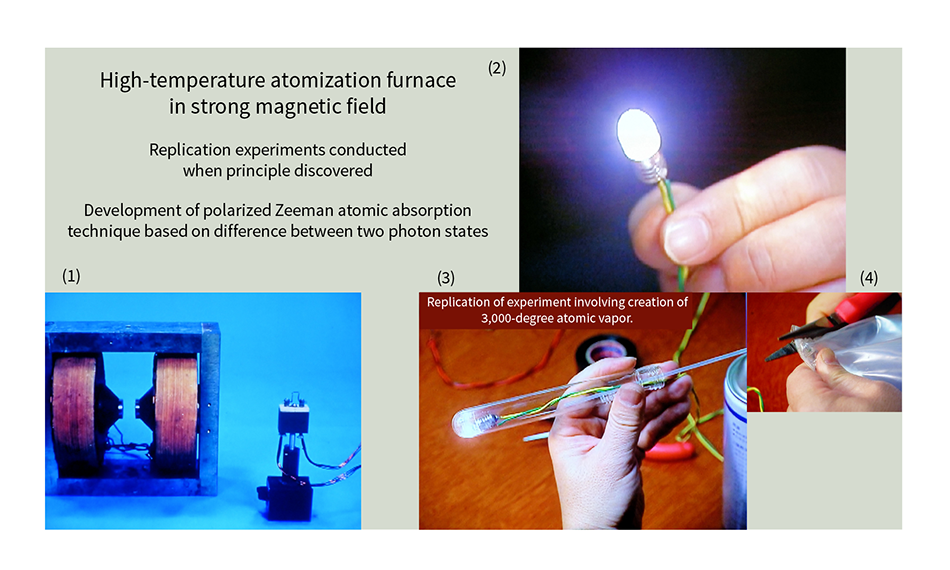 Photograph (1) shows a small magnet (fitted with wide-gap pole pieces designed for a 1-T magnetic field) with a magnetic circuit I designed and built myself by disassembling an old magnetron to remove the coil. When equipped with pole pieces that have a 5-mm gap, it can achieve a maximum magnetic field of 2 T. Next to the magnet is a high-temperature atomization furnace I made by cutting a soft tantalum (Ta: melting point 2,985°C) plate with scissors. (2) shows a small bicycle lamp. In (3), ignition occurs through oxygen purging (approx. 3,000°C). (4) I dismantled a bicycle lamp with pliers, extracted the tungsten filament, and used it as a high-temperature atomization furnace. (Some of these photos are from a replicated experiment conducted at the request of media).
Photograph (1) shows a small magnet (fitted with wide-gap pole pieces designed for a 1-T magnetic field) with a magnetic circuit I designed and built myself by disassembling an old magnetron to remove the coil. When equipped with pole pieces that have a 5-mm gap, it can achieve a maximum magnetic field of 2 T. Next to the magnet is a high-temperature atomization furnace I made by cutting a soft tantalum (Ta: melting point 2,985°C) plate with scissors. (2) shows a small bicycle lamp. In (3), ignition occurs through oxygen purging (approx. 3,000°C). (4) I dismantled a bicycle lamp with pliers, extracted the tungsten filament, and used it as a high-temperature atomization furnace. (Some of these photos are from a replicated experiment conducted at the request of media).
Einstein’s Brain
While Einstein’s brain went missing following its removal from his body shortly after death, it was discovered recently that the doctor who performed the excision had taken it back to his own home. Distinctive wrinkles are present on the surface of the human cerebral cortex, with the ridges and grooves being known respectively as “gyri” and “sulci.” One such gyrus on the right hemisphere of Einstein’s brain has a distinct upside-down omega shape, this being a region of the brain that is involved in movement of the fingers on the left hand. It is a feature that is known to occur in people who began playing the violin at an early age. The gyrus is located on the posterior of the frontal lobe. An adjacent gyrus responsible for processing the fingers’ sense of touch is located on the anterior portion of the parietal lobe. The region between these gyri separates the frontal and parietal lobes and is called the “central sulcus.” It has come to light recently that modern humans were the first to evolve special regions that coordinate movement and touch. That is, modern humans have developed a new nervous system that links this sulcus directly to finger muscles. Modern humans are the only species able to demonstrate proficiency with instruments such as a violin or piano, allowing us to play music with great speed and precision. It is fascinating to think that this evolution of a link between our fingertips and higher-order brain functions may have contributed to making monozukuri what it is. The weight of Einstein’s brain at the time of his death did not differ significantly from what is typical for someone of his age. Any stories to the effect that it was lighter or heavier than normal are not true. For his own part, Einstein spoke of experiencing creative feelings and thoughts when playing the violin.
Figure 6—Photograph of Einstein’s Brain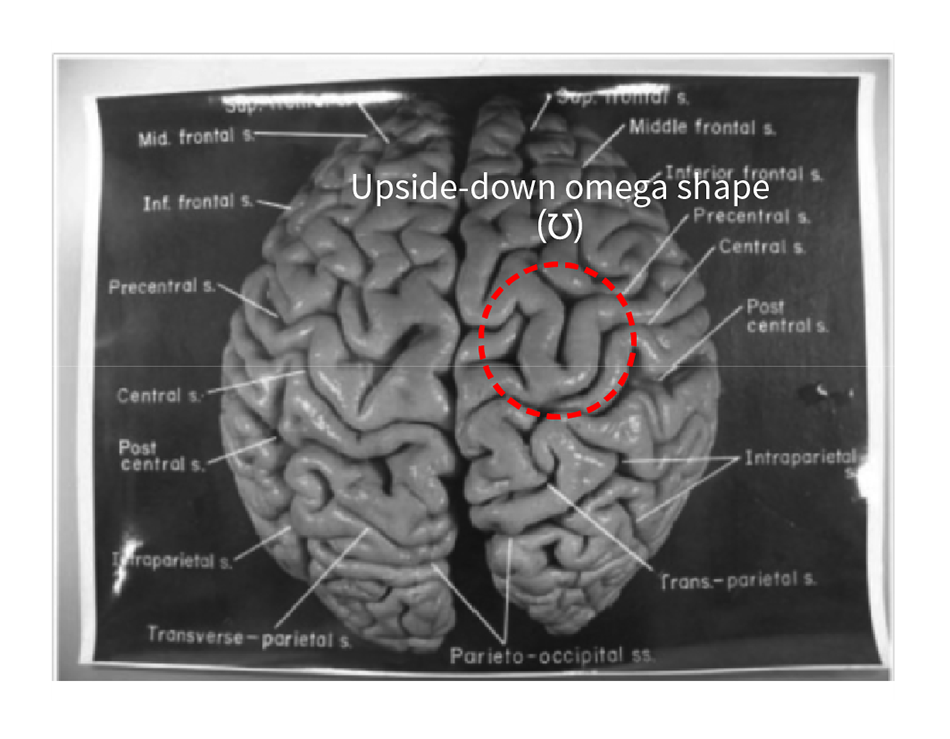 The doctor who removed Einstein’s brain from his dead body kept it at his home for many years. A gyrus in the shape of an upside-down omega is visible in the right hemisphere. The distinctiveness of this feature gained much attention when the photograph was discovered and it turns out that this is the region of the brain that sends movement commands to the fingers on the left hand.
The doctor who removed Einstein’s brain from his dead body kept it at his home for many years. A gyrus in the shape of an upside-down omega is visible in the right hemisphere. The distinctiveness of this feature gained much attention when the photograph was discovered and it turns out that this is the region of the brain that sends movement commands to the fingers on the left hand.
An image showing a cross-section of the longitudinal fissure (the region separating the left and right hemispheres of the brain) is also extant. This shows the corpus callosum, the bundle of nerve fibers connecting the left and right hemispheres. Looking at it, the corpus callosum appears large, especially toward the rear. It is said that this may facilitate high-speed interaction between the left brain that is primarily involved in analytical functions (and usually includes language areas also) and the right brain that hosts general coordination functions. Much about the specifics of neuroscience remains unknown.
The ability to grip with the fingers is something that modern humans acquired by way of our distinctive motor nervous system. The use of our fingers as tools also demanded a deeper level of thinking. It is here that the true nature of monozukuri can be found.
Relationship between Information Industry and Monozukuri
Today’s big corporations are underpinned by large numbers of affiliated companies, something that makes the relationships between them somewhat difficult to discern. A sense of these relationships can be obtained, however, by an analysis of the different layers in industry input-output tables. Meanwhile, I have written already about how the world’s disparities are tied directly to the fundamentals of ethics ( see Figure 1 in Article 3 of Part 1).
The economic disparities between people are being further exacerbated by innovations facilitated by how things work in societies where software predominates. In broad terms, I believe that ensuring the well-being of future generations also offers a basis for a new form of ethics.
About 10 years ago, when I was Director of the International Council of Academies of Engineering and Technological Sciences (CAETS, made up of the national engineering academies of 31 different counties at the time, including the USA, China, and the UK), I received an invitation from China to visit major companies like Huawei and Alibaba. This gave me an opportunity to exchange views with the senior management at these firms, within the scope of what information had been made publicly available. I was able to see the two companies’ information technologies for myself and was extremely impressed by how advanced the technology was for its time. A focus of senior management was to treat information technologies as a hub to enable vertical and horizontal engagement with large numbers of small and medium-sized enterprises (SMEs). In other words, the concept of fostering monozukuri was an integral part of their software strategy. This gave me a sense of the broad policy approach being adopted by rapidly advancing emerging nations.
The USA, and Silicon Valley in particular, remains at the global forefront of information technology. The world has also undergone significant changes, with major information technology companies now having reached a financial size comparable to that of nations, as exemplified by the group of companies that used to be known as GAFAM [Google, Apple, Facebook (now Meta), Amazon, and Microsoft]. As of April 2020, the GAFAM companies had a collective market capitalization of 558 trillion yen, surpassing the 539 trillion yen total value of the 2,170 companies then listed on the First Section of the Tokyo Stock Exchange. While the conventional wisdom has been that the ”jukochodai” (heavy industry) capabilities now seen as somewhat dated can be purchased using the money earned from information technology, this is now emerging as a structural policy problem as it has led to a shrinking of investment in industries such as shipbuilding (to take an example from the USA), thereby compromising the nation’s ability to maintain the warships vital to its defense.
To state the obvious, having software does not give you the ability to build hardware. Tangible and intangible goods are different and I believe it is necessary to develop plans that keep in mind both energy and entropy.
Relationship between Hardware and Software
It is widely accepted that the USA has historically been the leader of the post-war world. In some areas, however, this history has not always included valuing the foundations of monozukuri.
Prior to the Second World War, the USA was recognized as a world leader both in shipbuilding and in the iron and steel industry that supports it. Since then, however, these industries have languished to the extent that China, South Korea, and Japan together account for about 95% of all commercial shipbuilding (source: Japanese Shipowners’ Association). In global terms, only a very small fraction of new ships are now built in the USA. This has developed into a national security issue, having reached a point where it is having an impact on the availability of spare parts for aging American warships.
The current US administration has strong ties to the Rust Belt, a region that once boasted a vibrant steel industry that supported shipbuilding and automotive manufacturing.
How Monozukuri Facilitated First Flight by Wright Brothers
The Wright brothers pursued their research and development while also running a bicycle workshop. Their successful completion of the world’s first-ever manned powered flight took place in 1903. Given that they both combined roles as inventor, mechanic, and pilot, I believe they represent the very essence of monozukuri. Having extensive knowledge of numerous past failures, the academics of the time couldn’t believe that amateurs like the Wright brothers were able to get their heavy homemade aircraft to lift off into the air and successfully fly for approximately 260 m into a strong headwind. This was at a time when hot-air balloons were giving way to airships and the science of aerodynamics did not yet exist. It was considered inconceivable that a heavy machine could lift off under its own power using a propellor driven by a gasoline engine. Although the accomplishment was only witnessed by five onlookers, the fact that they really were able to fly was recognized as a true expression of monozukuri. While it is said that the Wright brothers themselves were unsure whether they could repeat the feat, it is attitudes like this that constitute the true nature of monozukuri.
Samuel Langley (1834-1906) was secretary of the Smithsonian Institution at that time and himself responsible for numerous accomplishments in astronomy and physics. He also made many attempts at flight, having developed a powerful engine and airframe funded by a large research budget. Despite this, he was unable to achieve manned powered flight. It is now believed that the reason for this failure was that, while he had achieved control of pitch and yaw, his aircraft had no control of roll.
The monozukuri capabilities of the Wright brothers, the proprietors of a bicycle workshop, were eventually recognized by the academic authorities and in 1948 the Wright Flyer went on display at the National Air and Space Museum in Washington (part of the Smithsonian Institution) alongside an official acknowledgement of their accomplishments.
Figure 7—Wright Brothers Making World’s First Manned Powered Flight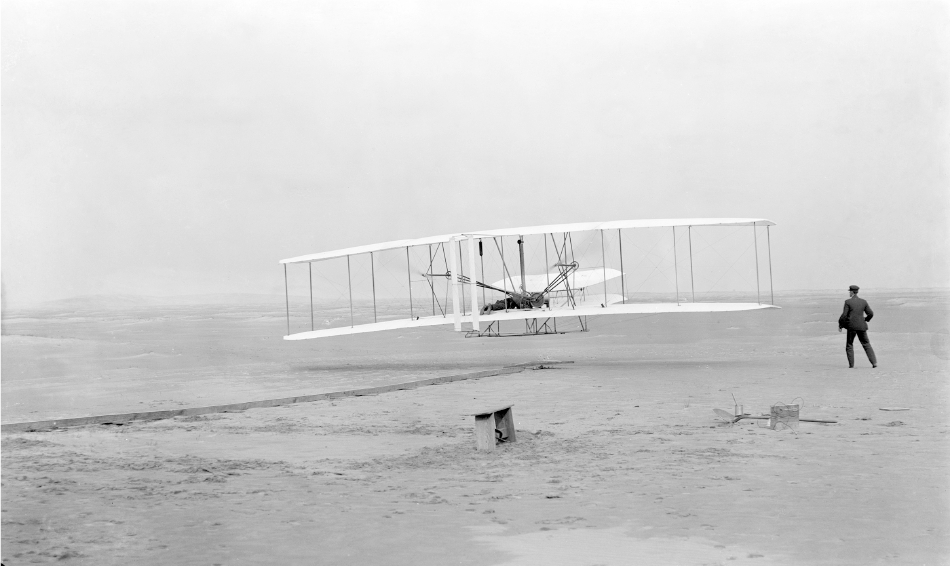 The Wright brothers succeeded in making the world’s first manned powered flight on December 17, 1903. This is a photograph of the event. The younger brother Orville piloted and the older brother Wilbur ran alongside holding the wingtip steady. Orville was also a highly skilled photographer and it is thanks to this that we have such a clear image of the flight. (Photograph source: Wikipedia)
The Wright brothers succeeded in making the world’s first manned powered flight on December 17, 1903. This is a photograph of the event. The younger brother Orville piloted and the older brother Wilbur ran alongside holding the wingtip steady. Orville was also a highly skilled photographer and it is thanks to this that we have such a clear image of the flight. (Photograph source: Wikipedia)
Dream of a Civil Aviation Industry
In May 1927, Charles Augustus Lindbergh (1902-1974) successfully accomplished the first solo nonstop flight across the Atlantic Ocean in the Spirit of St. Louis. The flight from New York to Paris lasted 33-and-a-half hours and covered a distance of 5,810 km. Even before this, there was someone in Japan who dreamed of flying across the Pacific Ocean and pioneering civilian flights to the South Seas. The man’s name was Shunichi Bando (1892-1977). A chance meeting I had with him shortly before his death led to his giving me a copy of his self-published memoir, shown in Figure 8.
The following account of Shunichi Bando’s career appeared in “Story of an Aviation Pioneer” edited by Ikuo Komori (1904-1988), who was also an aviation commentator.
Career of Shunichi Bando (compiled by the author from the text of “Story of an Aviation Pioneer” and checked against the chronology and other sources)
After graduating from Keio University, Shunichi Bando was employed by Nippon Yusen. He urged Seibei Kawanishi, head of the Kawanishi Zaibatsu and father of his classmate, Ryozo Kawanishi, to invest in the civil aviation business. He left Nippon Yusen in 1918 and, funded primarily by Seibei Kawanishi, founded Nippon Hikoki Seisakusho as a limited partnership that would go on to become the Nakajima Aircraft Company. He was appointed the inaugural manager of Nippon Hikoki Seisakusho at the age of 27. After serving as manager of the aircraft division at the Kawanishi Aircraft Company from 1920 (at age 29), he founded Nippon Koku (Japan Aviation Co., Ltd.) in 1923 and worked on establishing both aircraft production and air transportation technology in his role as managing director (Ryozo Kawanishi was the company’s president). At the time of the Great Kanto Earthquake, which also struck in 1923, he dispatched a rescue flying boat to Tokyo Bay via the port of Shimizu to aid the victims and help with carrying emergency mail. The Kawanishi Aircraft Company was established through a government policy directive in 1928 (resulting in the dissolution of Japan Aviation)*3.
He departed the company on harmonious terms in 1937 along with a number of colleagues (75 people) to establish Nippon Koku Kogyo where he served as managing director. Funded by Jinkichi Terada, the company established a facility on 165,000 m2 of land it obtained at Hiratsuka. The Terada Aviation Laboratory was also setup inside this Hiratsuka Works plant. Nippon Kogei Kogyo was established in 1945 and embarked on new areas of business, primarily involving coating techniques.
- *3
- The government policy directive referred to here was to focus more on the production of military aircraft than on the civil aviation business. Japan Aviation had mainly been developing flying boats for use on civil aviation routes. It was disbanded in 1928 and the Kawanishi Aircraft Company (President: Ryozo Kawanishi, Managing Director: Shunichi Bando) established to manufacture conventional aircraft, with a new plant being completed in 1931. Work on the development of new aircraft commenced in 1931 in response to a directive from the navy to begin prototype development. This was followed by four orders from the navy in 1934 to build prototypes of large, long-distance aircraft. The outcome of this was the Type 2 Flying Boat described below.
When you compare what is written in “Story of an Aviation Pioneer” by Shunichi Bando with the company history of ShinMaywa Industries, most of the accounts are in agreement. Some information that does not appear in the company history, however, is that Shunichi Bando (at age 27) worked as the operations manager at the Nippon Hikoki Seisakusho, a limited partnership established in 1918 with investment from Seibei Kawanishi and others; that it was he who (at age 29) was appointed manager of the aircraft division at the Kawanishi Aircraft Company established in 1920; and that in 1937, with the approval of company president, Ryozo Kawanishi, he left the Kawanishi Aircraft Company where they had experienced the highs and lows of working together over the 20 or so years since Nippon Hikoki Seisakusho was established and formed a new company, Nippon Koku Kogyo, serving as its managing director.
Recollecting this series of events, Shunichi Bando said that the large numbers of military personnel seconded to the company and the loss of freedom to manage the business and conduct research and development were factors in his decision to establish the fully independent new company. As it turned out, the company successfully developed a high-speed variable-pitch propellor. This technology is a true exemplar of monozukuri. While rumor had it that they had merely brought in advanced technology from Germany, the actual records show that the accomplishment was homegrown.
History | ShinMaywa Industries, Ltd.
Figure 8—“Story of an Aviation Pioneer,” Detailed Memoirs of Shunichi Bando, a Historic Figure in Japanese Civil Aviation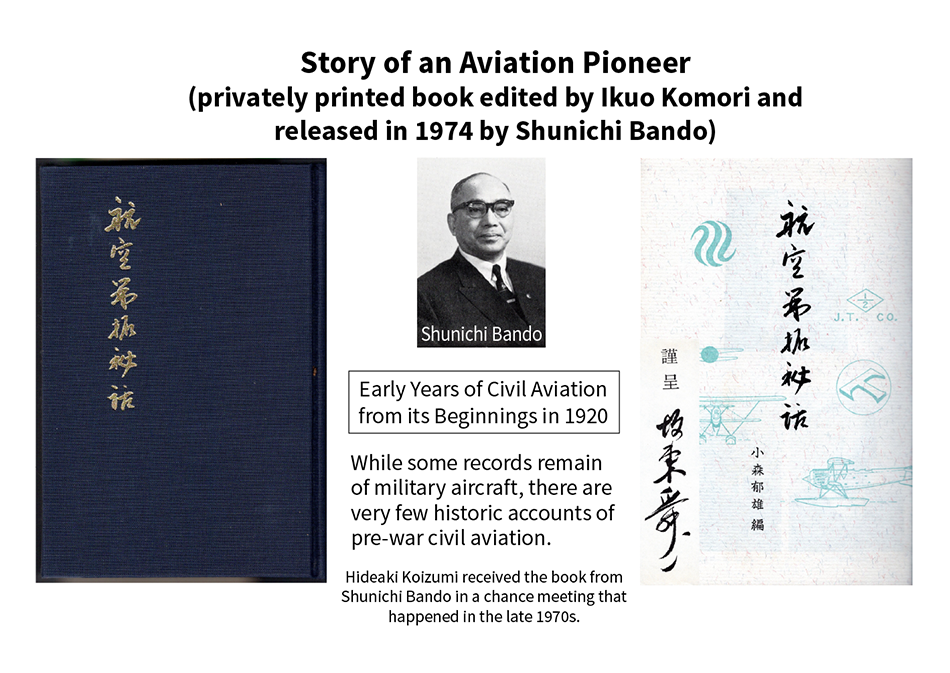 I received a copy of “Story of an Aviation Pioneer” (edited by Ikuo Komori and released in 1974 by Shunichi Bando as a self-published book via Kodansha) from Shunichi Bando himself. At the end of the war, records of pre-war aviation were disposed of or requisitioned by the General Headquarters (GHQ) of the occupation authorities at the same time as they were being burned by the army. Moreover, most of those aircraft that were still intact, whether civilian or military, were either buried in landfills or pushed overboard at sea, although some were also requisitioned by the US military. As a result, little remains from pre-war aviation, whether in the form of records or the aircraft themselves. Indeed, it is the paucity of writers on the history of Japanese civil aviation that makes this book by Shunichi Bando important.
I received a copy of “Story of an Aviation Pioneer” (edited by Ikuo Komori and released in 1974 by Shunichi Bando as a self-published book via Kodansha) from Shunichi Bando himself. At the end of the war, records of pre-war aviation were disposed of or requisitioned by the General Headquarters (GHQ) of the occupation authorities at the same time as they were being burned by the army. Moreover, most of those aircraft that were still intact, whether civilian or military, were either buried in landfills or pushed overboard at sea, although some were also requisitioned by the US military. As a result, little remains from pre-war aviation, whether in the form of records or the aircraft themselves. Indeed, it is the paucity of writers on the history of Japanese civil aviation that makes this book by Shunichi Bando important.
Figure 9—Kisarazu Airfield of Nippon Koku (Japan Aviation Co., Ltd.) circa 1925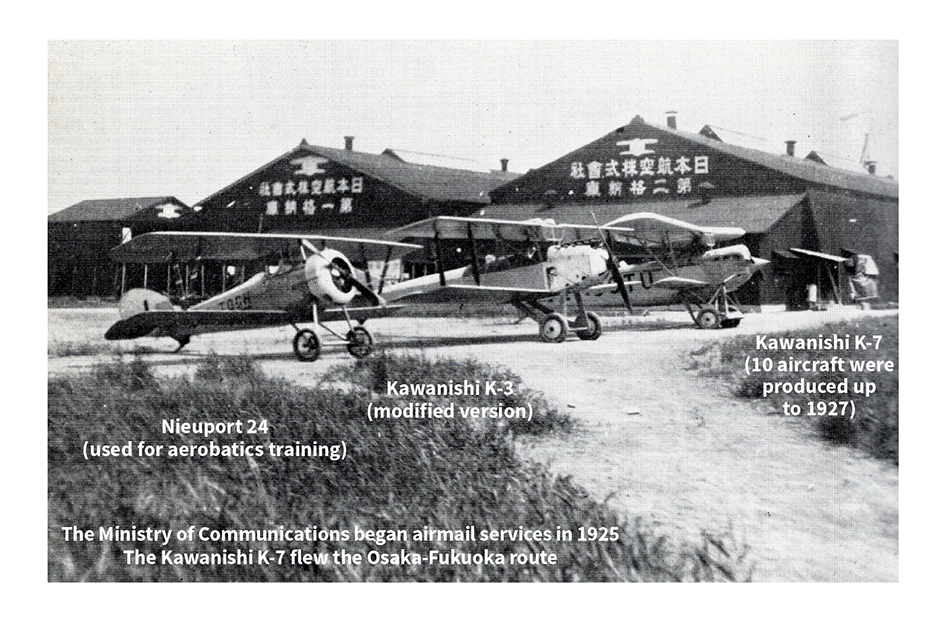 The photograph shows hangars and aircraft under development at the time at Nippon Koku, the company established with investment by Seibei Kawanishi (with his son, Ryozo Kawanishi, as company president) and at which Shunichi Bando was made operations manager at the age of only 27. Many of their aircraft were fitted with floats and operated as seaplanes. Note that, while it has the same Japanese name as today’s Japan Airlines, the two companies are in no way related.
The photograph shows hangars and aircraft under development at the time at Nippon Koku, the company established with investment by Seibei Kawanishi (with his son, Ryozo Kawanishi, as company president) and at which Shunichi Bando was made operations manager at the age of only 27. Many of their aircraft were fitted with floats and operated as seaplanes. Note that, while it has the same Japanese name as today’s Japan Airlines, the two companies are in no way related.
Monozukuri Basis of Japan’s Place at Forefront of Developing Aviation Routes
The initial inspiration behind what Shunichi Bando’s was doing came from the idea of flying boats that could land on both land and water. He recognized that the construction of large landing strips posed the first obstacle to putting the results of civilian monozukuri development into practice. In that regard, the core thinking behind his path from craftsmanship to commercial deployment was clear. It was based on the idea of “flying ships.” When he looked at the world around him, he saw that flying boats able to take off and land on lakes or rivers, even at inland locations, would obviate the requirement for large aerodrome infrastructure and the heavy investment it entails. On the coast, harbor locations sheltered from the waves could serve as airports. While I am very impressed by this insight, he also recognized that passenger safety is the top priority in the early years of a science or technology and the ability of flying boats to land at sea to make repairs if they ever had a fault was also very important. As it happened, they launched their first civil aviation route in the form of a return flight between Osaka and Kyushu. This was because, should the aircraft ever develop a problem, it could land on the typically calm waters of Japan’s Inland Sea. As the flying boats were equipped with small wheels, they were also able to take off and land at existing land-based airports. His monozukuri genius manifested in all sorts of different ways. The motto of the time was “hayaku, tooku, kakujitsu ni”(fast and far, reliably).
In fact, the south-bound routes extended as far as the equatorial South Seas islands. In fulfilment of his earlier dream, the Shirakumo (White Cloud), the large flying boat used for the first scheduled flight, took off from Yokohama with a load of passengers on March 6, 1940, flying via Saipan and landing two days later at its destination of Palau. This was a journey that had previously taken 10 days or more by boat. It is unfortunate that, in spite of this peaceful civilian initiative, the Pacific War was to break out with the attack on Pearl Harbor that took place in the pre-dawn of December 8, 1941.
Hiratsuka in Shonan*4 with Views out over the Pacific against a Backdrop of Mt Fuji
―An Unlikely Chance Meeting with Consequences for Aviation―
This brings us to the relationship between three men. This involved experiments conducted by Professor Sandi Kawada of the Tokyo Imperial University Aeronautical Research Institute (head of the propellor research laboratory and subsequently of the aeronautical research institute) using the institute’s wind tunnel, Hitachi Kokuki (which took over the research institute’s aircraft production team and at which Hitachi founder Namihei Odaira served as chairman), and Nippon Koku Kogyo (where Shunichi Bando was managing director). Shunichi Bando’s new company acquired a 165,000-m2 site in Hiratsuka City and quickly set about building its Hiratsuka factory and research center. Just as Namihei Odaira valued his second home at Hiratsuka, Bando chose a site that looked out over the Pacific Ocean with the outline of Mt Fuji visible in the background.
An unlikely history lies behind the chance meeting of Sandi Kawada, Namihei Odaira, and Shunichi Bando. Professor Kawada was working with the Tokyo Imperial University Aeronautical Research Institute’s 3-m wind tunnel that remains fully intact in Tokyo to this day (at the Research Center for Advanced Science and Technology located at the Komaba II Campus of the University of Tokyo). Namihei Odaira, founder of Hitachi, the company (and Chairman for a time of Hitachi Kokuki), was in Hitachi City and had built a second home as a place for contemplation at Hiratsuka. Shunichi Bando, meanwhile, was looking to move from Kansai to a new base at Hiratsuka. I hope to write more on this in the third of these articles.
Shunichi Bando’s Hiratsuka factory was completely annihilated by extensive aerial bombing and strafing during the final stages of the war, with the second homes of Namihei Odaira and Naosaburo Takao in Hiratsuka also being burned down at that time. Unfortunately, although it appears (and was in some cases documented) that Shunichi Bando and Namihei Odaira were not always in agreement with the military, they were nevertheless banished from public office by the occupation authorities. Despite this, the monozukuri accomplishments of these three men, especially their dreams for aviation, could look forward to being carried on by ShinMaywa Industries, a member of the Hitachi Group up until 2003.
Looking at the latest business plan of ShinMaywa Industries published in May 2025, I understand that they have built the once-abandoned flying boat and conventional aircraft business back into a major commercial operation.
- *4
- While it has sometimes been deemed otherwise, Kanagawa Prefecture currently treats Hiratsuka City as being part of the Shonan region.
Acknowledgements
I received a copy of Welcome Aboard, a recently published history of civil aviation (by Koji Yanagisawa, published in 2019 by Yobisha) from Masakatsu Yoshida, a friend of Shunichi Bando. I am grateful for the opportunity to revisit details of the story behind the early years of aviation, including the complex corporate changes that took place.



